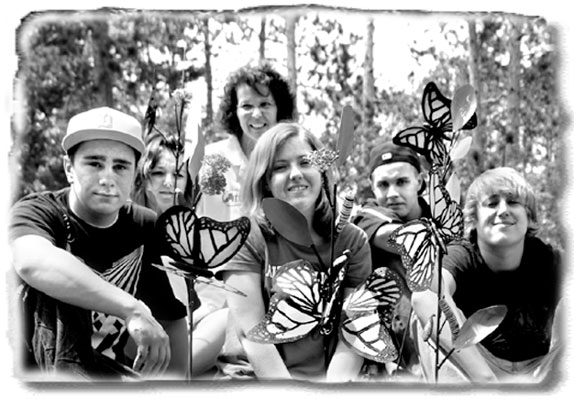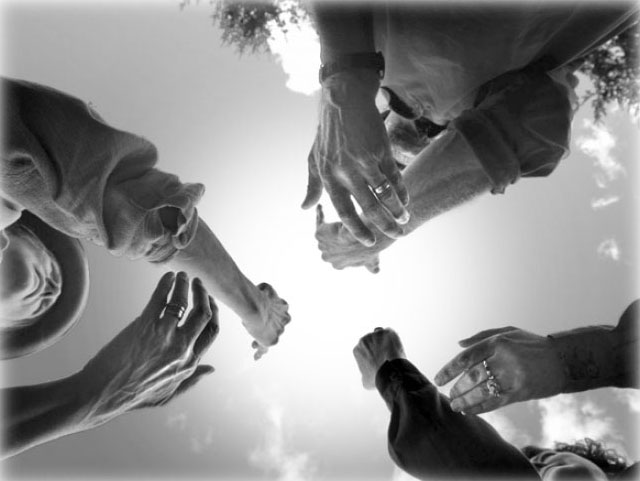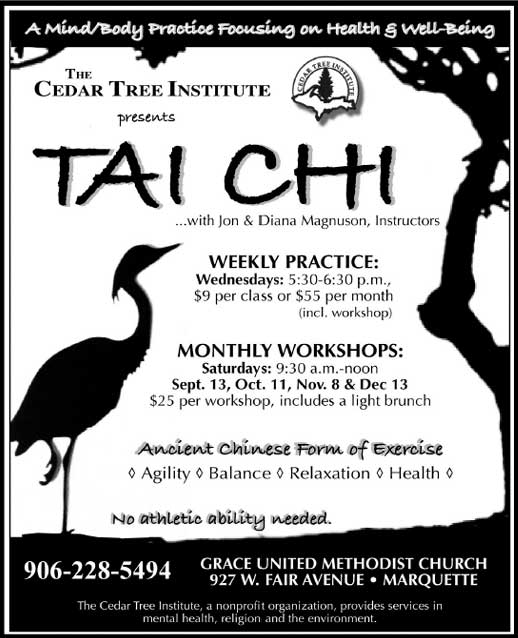from Marquette Monthly December, 2001
My drive north to the Keweenaw Peninsula has been marked by the cold, barren winds of early winter. Trees stand stripped of their leaves. The road glistens wet and gray under skies of foreboding clouds. The dark days of the Winter Solstice are near. The promise of coming night will greet me upon my return this late afternoon to my home in Marquette.
A few of us are gathered in a hundred-year-old church basement. Above us the weather-worn sandstone sanctuary is a reminder of another time, when institutional religious life seemed more natural, acceptable. Dignified and lonely, its steeple stands as a ghost-like beacon on a ridge overlooking Houghton’s Portage Canal. I’ve traveled here to lead a small group of priests and clergy in pondering the mystery and experience of our dreams, what John Sanford, an Episcopal priest, once called “God’s forgotten language.”
The trip north earlier this morning carried me through one of Michigan’s seven Indian reservations. On my left, the ever-blinking lights of a casino beckoned passing motorists from the highway bordering Keweenaw Bay. On this reservation as on others, but not known to most outsiders, the power of the dream lives on. The Midewiwin, a traditional Native American religion, after years of cultural disintegration, is on the rise. Increasing numbers of Ojibway, many of them young people, meet clandestinely to ceremonially burn cedar in the old ways, drawing upon words from an ancient language to dwell upon the mystery of their dreams.
The renaissance of the Midewiwin among Northern Michigan Indian communities is a reminder that the way of the dream is at the core of many of the oldest spiritual traditions. Claiming the inner world of dreams also has been heralded by writers, scientists and people from all walks of life, regardless of formal religious affiliation. Robert Louis Stevenson credits the plot of several of his most classic novels to such inspirations. Fredrich Kukule discovered a cornerstone of modern science when he recognized that benzene molecules were closed circles because of a single dream. Martin Niemoller, a leader of the German Resistance to the Third Reich, attributed a dream to his decision to publicly oppose Hitler during World War II.
My own journey into the strange, intriguing world of the dream began twenty years ago in the mountains of Washington State. Prompted by troubles in my work and personal life, and with a suggestion of a friend, I first began to listen to my night dreams during a retreat at Holden Village. When I stumbled into my own personal universe of symbols and feelings, I was first astonished, a bit embarrassed, then humbled. Where do these images originate, I asked myself? Who could be a mentor for such a hidden world? Why had no one in my psychiatric training or my theological education even mentioned that dreams could hold important clues for navigating the challenges of ordinary life?
I was soon to discover, as others before me, that most of the answers to those questions lie in messages from the cathedrals of technology and materialism which have shaped us since the Industrial Revolution of the eighteenth century. We have been led to believe that what we cannot see, touch or measure is not real. Much of the religious tradition of the West also has fallen under that spell. Historically, the power of the dream fell into disrepute in the fourth and fifth centuries with the writings of Thomas Aquinas, who himself, ironically, was influenced significantly by his own dream experiences. During my initial search into the background of such experiences, I also discovered that for the Christian community in recent years there has appeared a new appreciation of this sacred path.
The interest of the dream world in our own time is undoubtedly related, in large part, to the disillusionment of the promises of the twentieth century. We carried an obsession with what we believed to be a trajectory of unending prosperity and health promised to us by education, medicine and technology. Things didn’t work out as we expected. Harry Potter, a story of a school of wizards, currently dominates the shape of modern media. Addictions and anxiety disorders are rampant. We are medicating epidemic numbers of our children for behavior disorders. Whether the world is a safer or healthier place for most people remains, for many, an unanswered question.
There also is a growing acknowledgment that our inner lives define our individual paths more than we have imagined. In his recently published The Emotional Brain, Joseph LeDoux, a professor of Neural Science at the University of New York, teasingly reminds us of the power of emotions over reason and will power. He recounts that Charles Darwin once put himself to the test of whether will power can overcome a strong emotional response. Darwin wrote, “I put my face close to the thick glass plate in front of a poisonous snake (a puff adder) in the Zoological Gardens with the firm determination that I would not move if the snake struck at me. But as soon as the blow was struck, my resolution went for nothing, and I jumped a yard or two backwards with astonishing rapidity. My will and reason were powerless against the imagination of danger which had never been experienced.”
In the world of the dream, a mix of irrational and emotional forces reigns. Listening to dreams brings a humility to the dreamer. I am always quietly amused at casual dismissals of the dream life by individuals. It’s no wonder many prestigious and self-controlled individuals never choose to reveal glimpses of their unconscious lives. We know, of course, the truth that lies behind such resistance. The contents of our dreams appear not only bizarre, but frequently violent, sexual and comic. They are, more frequently than not, indiscriminate in their occasions of nudity and profanity.
From a modern perspective, Carl Jung (1875-1961), next to Freud, is the most prominent of psychiatrists who have lifted up the power of the dream. He differed from Freud on several ideas, most notably his own conviction that the unconscious has a power of its own that moves each individual toward a sacred purpose. For Jung, there was much more to life than random coincidence or some simple equation that predicts the strong always victorious over the weak.
Jung’s own life’s work revolved, in fact, around a peculiar dream he had as a young child in Switzerland where his father served as a pastor in Zurich. Because of the nature of that dream, he revealed its content only at the end of his life. As a youth, Jung dreamed that one day the clouds opened and a pile of excrement fell from the sky, covering the village church. Years later, he realized his life’s work was to humanize the rigid, proper and in many ways inhumane religious life of his time. The dream, bold, dramatic and humorous in its message, had pointed the way.
Since ancient times dreams have informed people from all walks of life. I have often wondered about Bishop Frederick Baraga’s attitude toward the dream life of the Native Americans with whom he worked and traveled as the beloved “snowshoe priest” here in Northern Michigan. Baraga is well known for having translated and compiled the first Ojibway dictionary. Although most Jesuit priests were skeptical of the dream language of Native people, there are no records of Baraga’s personal position on this matter. He most certainly knew of the Midewiwin, the dream society popular among the Ojibway of his time. What is of interest in this respect is that Baraga certainly knew the story of a peculiar dream of Martin of Tours, born in 316 A.D. in what is now the Republic of Hungary. We know Baraga was acquainted with the story of St. Martin of Tours, for this fourth-century personality always has played a special role within the most revered European traditions of Catholicism.
As a soldier in the army, one day Martin of Tours, so the story is told, is reported to have seen a beggar at the city gate. He cut his own cloak into two, giving the man half. That night we are told he had a dream in which Christ was wearing the half cloak. Later baptized, he became Bishop and a conscientious objector to the military. He soon established a monastery outside of Poitiers and, as a Bishop, chose to live in a cave and live a life of poverty. He dedicated his life to causes of justice and peace. Martin of Tours is considered by many to be the Patron Saint of France. Martin Luther, the famous Protestant reformer of the sixteenth century, was named after him because he was born on the eve of St. Martin’s Day ( November 11).
In my own work with university students over the years, I’ve discovered that dreams can, at times, be especially helpful in revealing situations that might be more difficult to admit on a conscious level. One college senior shared with me the following dream:
“I am in the middle of an ocean in a boat. I have no oars or sail. There is no wind.”
This young man was an idealistic individual who “peaked early” as the saying goes. He was extremely popular in high school and had a bit of a superficial attitude toward more complex situations of life. Often dream images that appear puzzling at first, and even humorous, also are blatantly honest. Students frequently dream of traveling in boats or cars that someone else is driving or steering, hints that they are not in control of circumstances as much as they might hope or think.
Some years ago I recall a personal dream in which I was attempting to juggle four balls and kept dropping them on the ground. (No surprise for those who know this writer.) A voice calmly suggested in the dream, “Why don’t you try three?” The next morning I took the hint and did some careful prioritizing of commitments and work schedules. My life shortly thereafter reflected, as my family can thankfully attest, a better balance.
Not all dreams, of course, carry the same importance. But sometimes a dream speaks to life’s transitions in powerful, unforgettable ways. I remember a grandmother in Oregon relating to me a memory of her own mother who had come west from Wisconsin in the late nineteenth century. The grandmother reported that her mother would frequently have a recurrent dream. It would portray, quietly and beautifully, the first snowfall she could remember from her childhood. Those of us who have shared the early years of our youth here in Northern Michigan probably carry a similar appreciation for such memories. There always is a sense of gentle magic in such memories. Homes, garages, forests, streets, shacks and garbage dumps are all softly covered with a clean white blanket of pure white, often shining under stars and moonlight. Within a day or two of such a dream, the grandmother reported, her own mother would hear of a close relative or friend’s death.
Some years later, I shared the story of this reported dream with a group I was addressing. A gentleman came up and told me his own father also had a similar recurring dream. As with the story in Oregon, after each such dream, news of the death of a loved one would follow in a day or two. But there was a difference in dream content. In this man’s case, he mentioned his father dreamed of an outhouse being emptied. We both smiled. I related to him a saying that the writer Nikos Kazantzakis recalled from his childhood on the island of Crete. “When a man dies, he leaves behind a little wool, a few bleats, and a huge pile of dung.”
My work with the clergy here in the Keweenaw church basement has been relaxed and comfortable. There has been plenty of laughter. There also has been extensive conversation about the appropriateness of when to share dream material with others. With the sacred, very personal nature of many dreams, the choice to disclose personal experiences is often a matter of careful judgment. Many of us who are clergy have discovered this lesson the hard way. One ordained woman in our group told of an experience on a retreat when she decided to share a personal dream experience with a group during a Bible Study. She mentioned to us that it had taken a measure of vulnerability and courage. She described the awkward silence following her sharing. She continued, shaking her head with a smile, “One of the women in the Bible Study group finally broke the silence with the question, “What’s for lunch?”
When we finish our dream sessions in the Keweenaw church basement I distribute a gift of a small dream catcher to each participant from a beaded deerskin bag. Dream catchers are carefully crafted symbols, still traditionally used by the Midewiwin but also recently popularized and available from gift shops and bookstores. These have been hand-made by a close friend, a member of the Keweenaw Indian community, for this select occasion. I was told that a group of traditional Native elders, upon seeing such a religious symbol designed obtrusively into the carpet of a Michigan casino a few years ago, demanded it be removed from the floor at a cost of hundreds of thousands of dollars. This demand was met, but only after a bitter dispute among the tribal council. The struggle to recover the sacred power of the dream continues among many Native communities just as it does among many followers of Judeo-Christian traditions.
My drive back has returned me home shortly after dark. The lights of Marquette sparkle against the skyline. The twin steeples of St. Peter’s, silhouetted above the city, cast a gentle protective watch over our community. Taking a few moments to drive down to the harbor, now secured and lonely for the winter months, I spend a few moments staring off to the far edge of Lake Superior’s dark horizon.
The historic lamps that illuminate the hundred-year-old neighborhoods above the harbor park remind me of another kind of hidden history of our community. One you never will read about in newspapers, legal documents or bank records. It’s a history of the inner lives of people, the dreams of ordinary people who have lived and worked quietly among us: French immigrants, the English and Irish, Native Americans, the Finnish and the Swedes. Most of them were not destined to carry the prestige of the wealthy, or the notoriety of the more well-known historical figures who in politics and business deals have defined our city’s heritage. But it is the inner lives of such ordinary people that have shaped the real soul of towns like ours. They have carried magnificent dramas that never have been told. Among those stories are dreams. Dreams that have changed the course of marriages, professions, religions and relationships.
From the Midewiwin and other great religious traditions, we learn that dreams need not so much perhaps to be understood as much as simply listened to and respected. The vast majority of our dreams never will be consciously remembered, yet they go on quietly, and sometimes not so quietly as Carl Jung once said, bringing things together, making all things new. The great spiritual traditions of the world promise that something is at work within each of us, part of a mysterious pattern, often startling, sometimes frightening, ultimately loving.
It’s been a long day. Now safely back at my home, I turn to shut the light off for another night, ready to slip into the world of sleep. A cold wind gently rattles the windows of our old house, the dim light of a street lamp illumines the empty, shadowed street below. On my bed stand, penned in a worn journal, is a prayer from the Talmud, an ancient, holy text of the Hebrews.
“Sovereign of the universe, I am thine and my dreams are thine. I have dreamt a dream and do not know what it is. Whether I have dreamt about myself, or my companions have dreamt about me, or I have dreamt about others—if they are good dreams, confirm and reinforce them like the dreams of Joseph. If they require a remedy, heal them. As thou didst turn the curse of the wicked into a blessing, so turn all my dreams into something beneficial for me.”
– Jon Magnuson
December 2001






